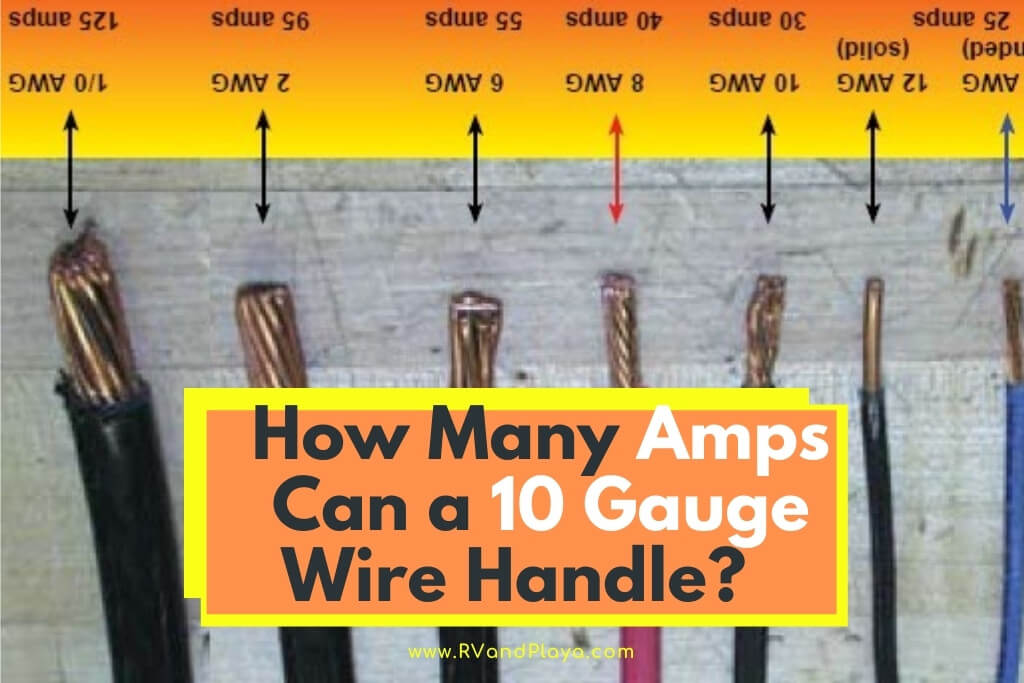Contrary to common sense and literal thinkers everywhere, the gauge of a wire is determined by the lowest number, not the highest. An 8 gauge wire is thicker than a 14, for instance. Sort of like shotgun shells but for Sparky instead.
So, how many amps can a 10 gauge wire handle? According to the NEC 310-16 Allowable Ampacities of Insulated Conductors, 10 gauge wire is capable of conducting 30 Amps at a temperature rating of 60ºC. Of course, not everything is as cut and dry as that. Different temperature ratings and usage allow for some wiggle room.
For the most part, you’ll find 10 gauge wiring in larger appliances such as refrigerators, air conditioning units, washers and dryers, and electric water heaters.
Ten gauge wire isn’t generally found in residential wiring outside of those parameters.
However, it can be used in situations where the amperage is lower than 30 amps, such as on a 25 amp circuit.
Table of Contents
Can You Use 10 Gauge Wire For A 20 Amp Circuit?
A 20 Amp circuit can run a 10 gauge wire, so long as it can take the upsize. Most circuits can handle one upsize because aluminum wiring is also a thing, with aluminum being a larger gauge than copper.
However, running 10 gauge wire from a 12 gauge circuit breaker would be far more expensive in the short term.
It will save an incremental amount of money in the long term since there’s less resistance with a thicker wire running the same amps as a thinner gauge wire would.
Another problem may be the side-screws on receptacles. They often are designed only to handle the right gauge wire for the load they are built for.
Installing a larger gauge could be problematic trying to get the side screws clamped down correctly.
Read also: How Many Amps Can a 14 Gauge Wire Handle? (Best Tips)
What’s The Voltage-Drop On 10 Gauge Copper Wire?
Voltage-drop depends on the amperage, distance, and gauge of the wire. For 10 gauge, copper wires, running 15 amps, the voltage drop is a maximum of 3% at 100’.
When running wire, it’s important to understand the level of voltage-drop according to the length of the wire and the amps you’re running through it.
If you’re going to run a workshop on a single circuit, 30 Amps may seem like a lot, until you have multiple tools running on it.
A table saw alone can run up to 16 amps. Probably not important if you’re alone, but with multiple people running equipment, the circuit is vulnerable to overload, which will trip the breaker.
Most residential wiring is 14 and 12 gauge which can run 15 and 20 Amps respectively. Running a 10 gauge wire off of a 20 Amp circuit isn’t going to increase your amperage, as you’ll still have 20 amps regardless.
Running a 10 gauge wire to a 30 Amp circuit is more ideal, but that’s generally used for large appliances rather than running a workshop.
Read also: How Many Amps Can a 12 Gauge Wire Handle? (Best Tips)
What’s The Difference In Copper And Aluminum
Aluminum is in the top five metals for electrical conductivity but it doesn’t match copper, silver, and gold.
Running electricity through an aluminum conductor creates a side effect where the aluminum conductor creates an oxide layer along the surface of the wire.
This oxide layer serves as a resistor, limiting the capacity of the aluminum conductor.
Essentially, 10 gauge aluminum wiring is as effective as 12 gauge copper wiring, since aluminum needs to be thicker to conduct the same level of electricity as a copper wire.
Copper wire can handle 30 amps at 10 gauge thickness and, unlike thinner gauge aluminum and copper comparisons, 10 gauge aluminum wire is rated to handle the same load as 10 gauge copper wire.
You can check the gauge differences between aluminum and copper here.
Ten gauge aluminum wire can adequately conduct 30 amps and can be used in just about any capacity as copper wiring.
Can A 10 Gauge Wire Handle 40 Amps?
Though it’s not rated to, a 10 gauge wire can handle 40 Amps. In fact, it’s often found in air conditioning with a 40 amp breaker.
If you’re running 10 gauge wire to the breaker, you’ll have to upsize the breaker to 40 amps, if one doesn’t already exist.
Also, you can’t run it through any kind of insulation or anywhere near something flammable. The wire should also be naked so the heat created from running 40 amps through a ten gauge wire will possibly melt through the insulation/jacket.
When 10 gauge wire is used in air conditioning units, it’s often only for the start-up process on the condenser. It doesn’t conduct 40 amps constantly, which would make it quite warm and possibly too hot to touch.
Applications For 10 Gauge Wire
While not commonly found in residential use, like 12 and 14 gauge wiring, 10 gauge wire is still used in a variety of applications.
- Central air conditioning
- RV appliances
- Window A/C units
- Dryer units
- Vehicle alternator
- Vehicle battery
A lot of these devices use a lot of juice when they start up, necessitating something larger than 12, 14, and 16 gauge wires.
Temperature Rating Differences
Temperature ratings affect the ampacity of 10 gauge wiring, like any gauge, according to how much heat is generated when a current is applied to it.
| 60ºC | 75ºC | 90ºC | |
|---|---|---|---|
| 10 Gauge Copper | 30 Amps | 35 Amps | 40 Amps |
| 10 Gauge Aluminum | 25 Amps | 30 Amps | 35 Amps |
The common understanding is that 10 gauge wire should only be used on a 30 Amp circuit. While this is true for most residential homes, where the wiring sticks to the lower temperature ratings, it’s not always the case.
There are several different insulation types that are used for specific applications where the temperature created by the current flowing through a wire exceeds certain specs:
- 90ºC or Less: Polyethylene, Neoprene, Polyurethane, Polyvinylchloride, Polypropylene, and Polyethylene
- 125ºC or Less: Polyvinylchloride PVC irradiated Nylon, Kynar Polyethylene, and Thermoplastic Elastomers
- 200ºC or Less: Kapton, PTFE, FEP, PFA, and Silicone
The different materials work great as insulation/jacketing over the copper or aluminum wire because they are highly resistant to heat.
This is why—in certain situations—when 10 gauge wiring is used for 40 Amp applications, it should be naked wiring that can’t melt off the insulation.
You’ll often notice that the wiring inside of air conditioning units is exposed in this way and that it is generally 10 gauge wire running from a 40 Amp circuit.
It should also be installed well away from anything that has no tolerance for excess heat, such as clothing, sheetrock, etc.
The higher currents through higher temperature rated wiring creates more heat from the passage of electrical current, necessitating the use of better, longer-lasting jackets such as Kapton and PTFE.
Final Word
Copper and Aluminum wiring are the two most common metals used in residential and commercial electrical work today, with aluminum expanding to larger roles.
As listed in the NEC Articles, 10 gauge wires of either will accommodate 30 Amps.
Ten gauge wiring is mainly used in larger appliances but its still pretty common in residential settings, including water heaters, stoves, dryers, and A/C units.
So long as the NEC articles are utilized when running any kind of wire, it’s a safe bet that your electrical equipment is secure and will work effectively without throwing off too much heat.
Here are some of my favorite tools & equipment´s
Thank you for reading this article. I hope it helps you find the most recent and accurate technical and repair information for your car. Here are some tools that I use as an automotive technician and hope you´ll also find helpful.
There are affiliate links, so if you do decide to use any of them, I´ll earn a small commission. But in all honesty, these are the exact tools that I use and recommend to everyone, even my own family. (NO CRAP)
To see all my of most up-to-date recommendations, check out this resource that I made for you!
References
https://www.achrnews.com/articles/135676-what-most-techs-get-wrong-about-wire-sizing
Recent Posts
When it comes to the gauge (thickness) of copper wire—or aluminum—the allowable current flow is debatable between what is safe and falls within code, and what it can carry. For safety...
When it comes to wire sizes and the supposed amperage, they can tolerate there is a general rule of thumb that is applied across the board for various wire sizes. However, it’s not always as cut...


